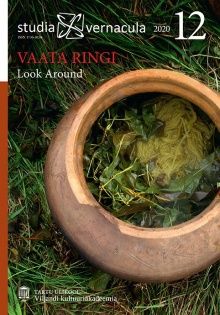Pärandtehnoloogiline käsitööuurimus: lähenemised ja väljavaated / Craft research and traditional technologies: practices and perspectives
DOI:
https://doi.org/10.12697/sv.2020.12.16-45Abstract
The article provides an overview of the practices and perspectives related to craft research and traditional technologies as studied and taught in the Estonian Native Crafts Department in University of Tartu Viljandi Culture Academy. Academic craft research is discussed in the context of neighbouring disciplines in the humanities, such as ethnology, semiotics, archaeology, art history, and conservation, amongst others. Against this background, the distinctive traits of craft research are foregrounded. The article also aims to position Estonian craft research amongst its peer disciplines. We hope that it sparks constructive discussion and further cooperation with interested partners in order to advance craft studies in general.
Within the framework of an academic institution, craft research inevitably involves difficulties that need to be overcome as academic knowledge is traditionally considered to be abstract, and not skill-related. Traditional craft skills are part of intangible cultural heritage, therefore it is important to pay them due respect in research and higher education.
The Committee of Craft Terminology was established in 2016 at the initiative of the Estonian Native Crafts Department. The definition of craft skills they work with is: the combined set of manual, bodily and intellectual practices that form part of intangible cultural heritage, the usage of which produces examples of material culture. It is acknowledged that traditional craft skills are not objectively given, but are constantly constructed by the masters of craft as well as by researchers. In craft research orientated to traditional technologies the following objects of study may be listed: artefacts, technologies, materials, tools and workshops, master skills. The chief research questions are: how are artefacts made?, what skills does this require?, what are the reasons behind doing certain things? This article focuses on the application of practice-led research, drawing on examples from four outstanding MA theses defended at the Estonian Native Crafts Department of UT VCA.
Ethnographic research has provided a firm platform for the development of Estonian craft research. The importance of skills and their documentation was already acknowledged as a vital aspect in understanding local material culture in the 1920s at the beginning of systematic ethnographic data collection by the Estonian National Museum. The questionnaires sent to the members of the network of the museum’s correspondents all over Estonia have yielded a great deal of interesting information about various craft-related practices. And, to date,not all of this material has been exhaustively studied.
The most interesting ethnographic studies concerning traditional technologies combine thorough fieldwork, skilful use of written responses from correspondents, outstanding observational skills, and a deep knowledge of local dialects and folklore.
Especially interesting developments in the study of old technologies have been initiated during the past few decades by archaeologists using experimental methods. When dealing with ancient artefacts whose makers can no longer be observed or interviewed and for which there is archival information, novel methods have to be employed. Experimental creation, chemical analyses, or study under a microscope may supply interesting data about the artefacts in question, the ways they were made and the material they were made from.
Practice-led research usually starts with the question ‘How is it made?’, and the first stage of data collection comprises ‘close observation’, which involves a detailed mapping of all the physical and observable parameters of the object under study, including drawing up a technological description with notes about its wear, defects, repairs, and so on.
A craft researcher should be a skilled craftsperson him- or herself in order to be able to pose meaningful questions about the technological aspects of the objects being studied. A craft researcher can detect, describe and reconstruct the methods of making of an old artefact in a way that will make it possible to repeat that original process of making, bequeathing us a material object technologically similar to the original.
How might craft research contribute to the humanities in general? This article offers three keywords: materiality, bodily knowledge, and environmental sustainability. The co-operation between master and his/her material is crucial in skilled craft activities. The notions of embodied knowledge and embodied cognition that originate in phenomenology, as well as the concept of tacit knowledge associated with Michael Polany, are cornerstones in the understanding of traditional crafts. Environmental sustainability is a key question that will increasingly shape human activity. Studying traditional technologies, tools, materials, skills and crafts provides a much-needed basis in the general turn towards a more sustainable lifestyle
Keywords: Craft research, practice-based research method, material culture, craf

